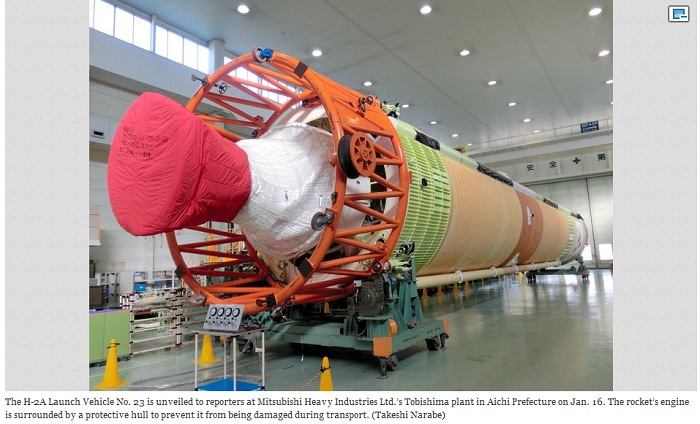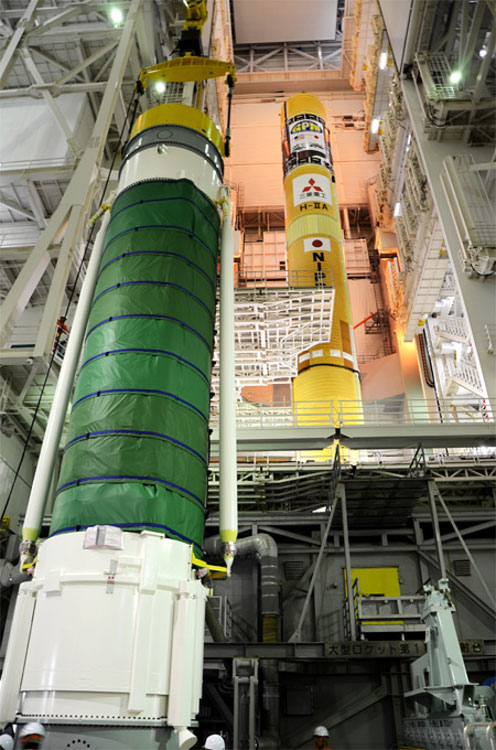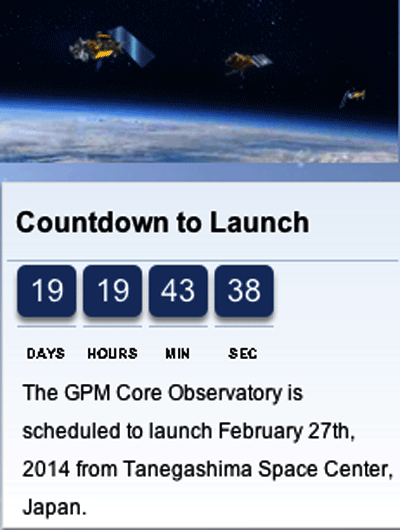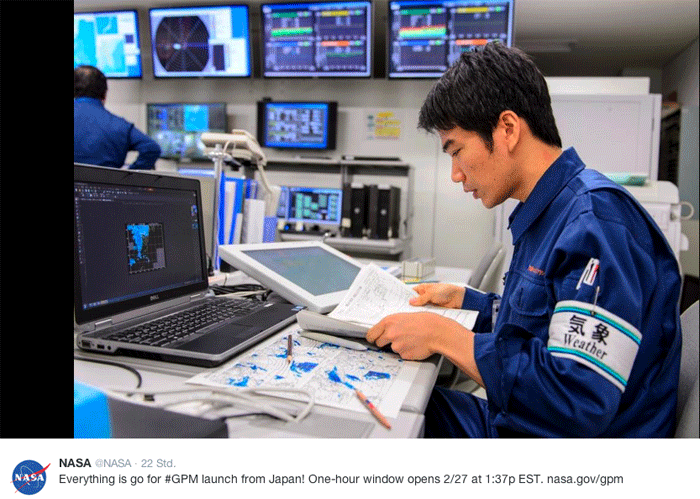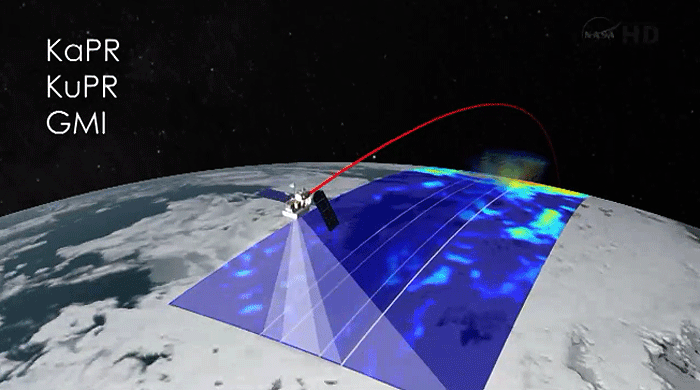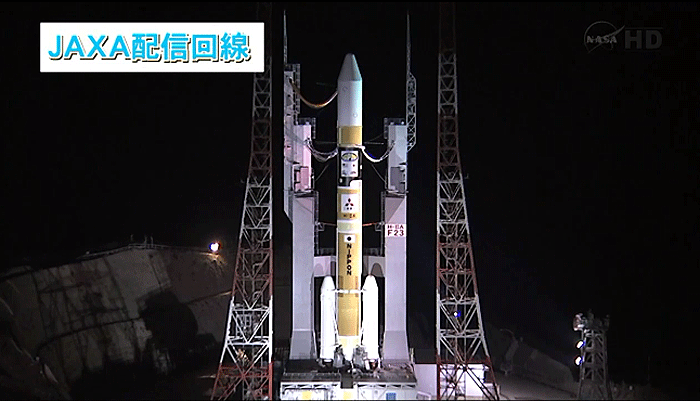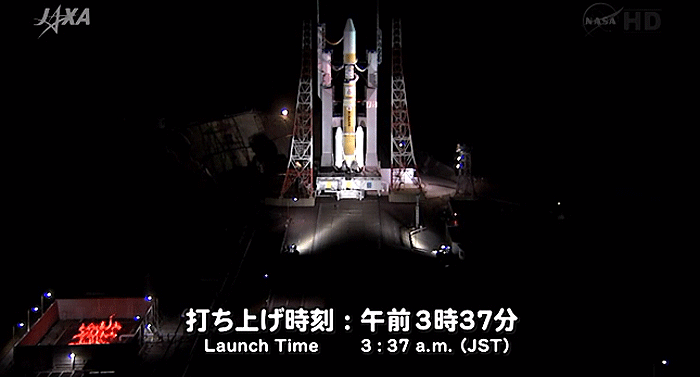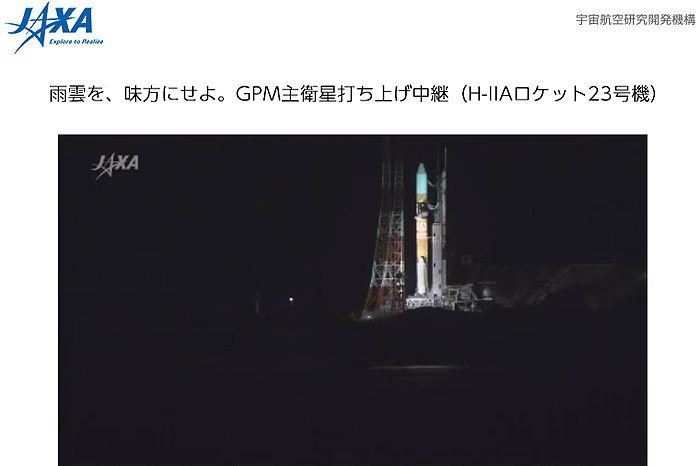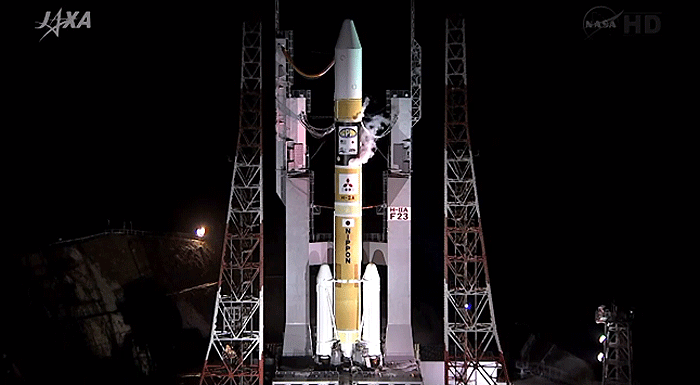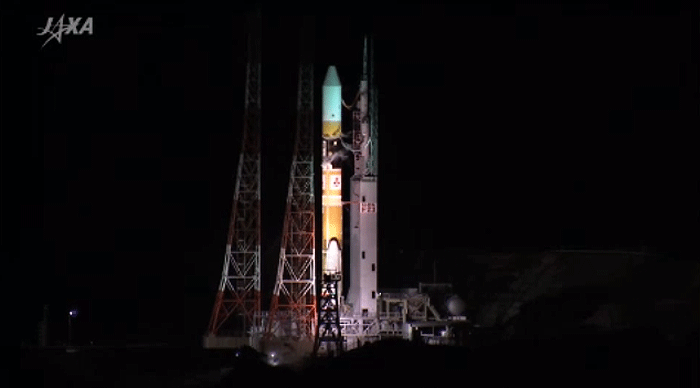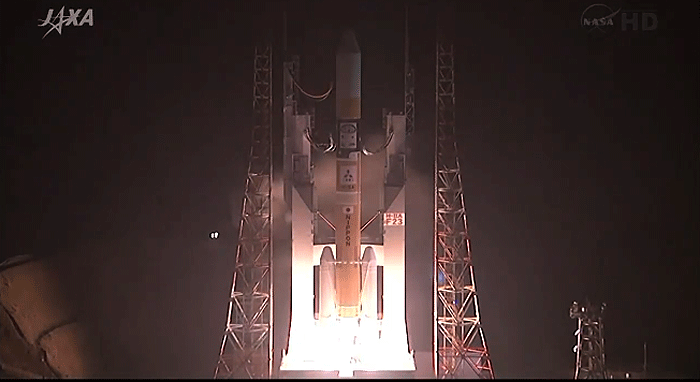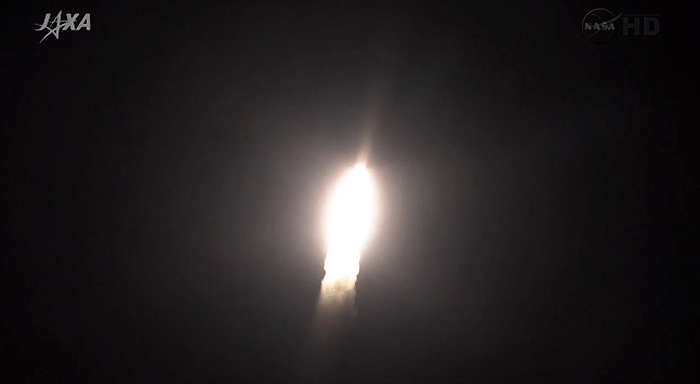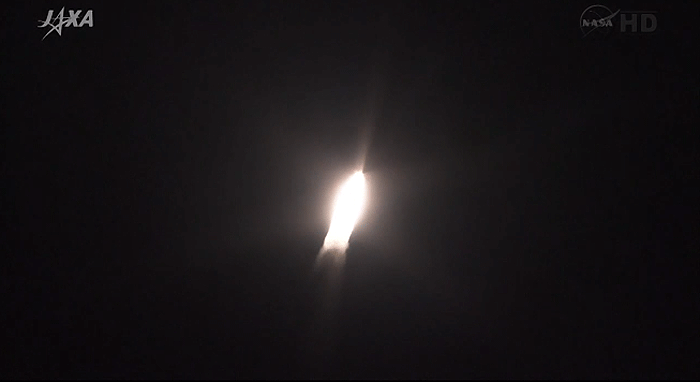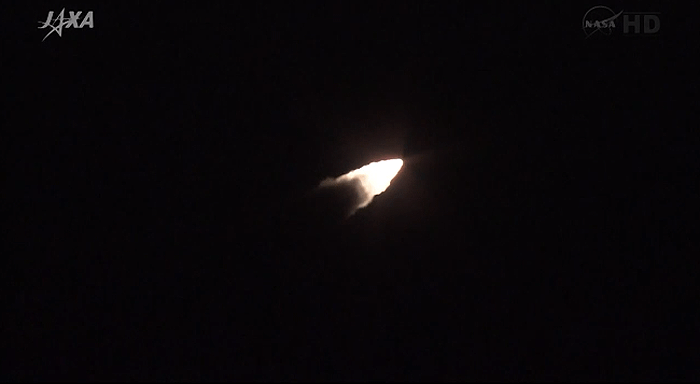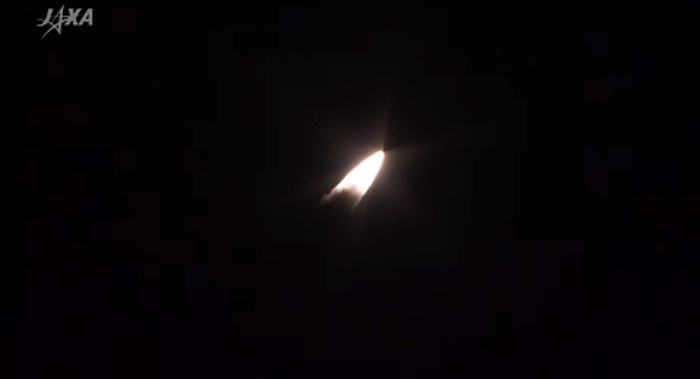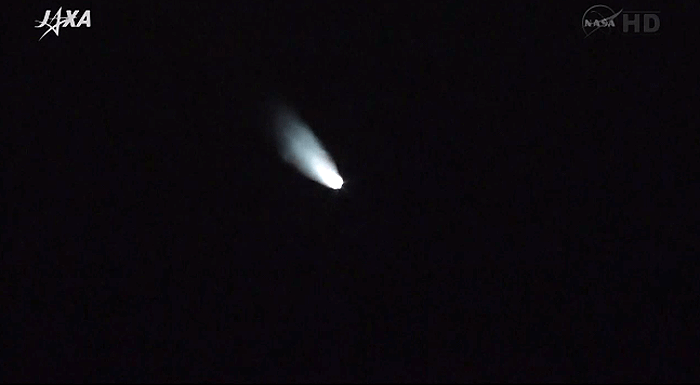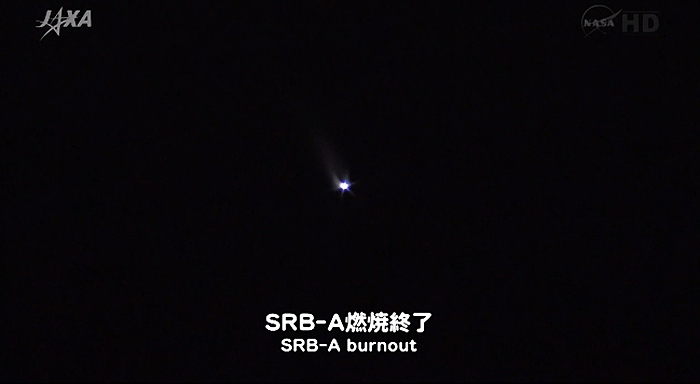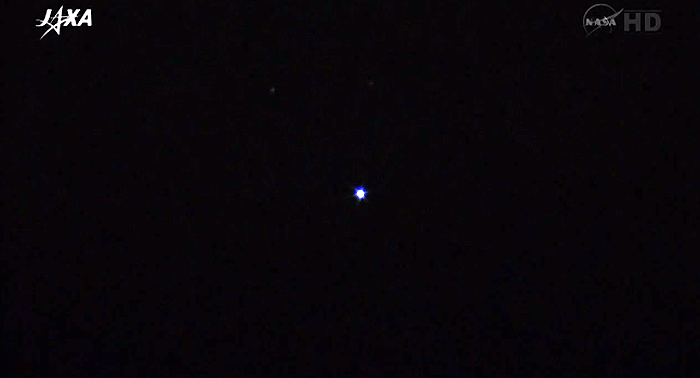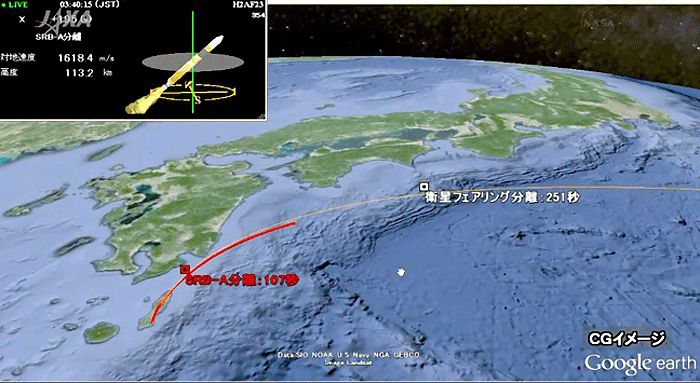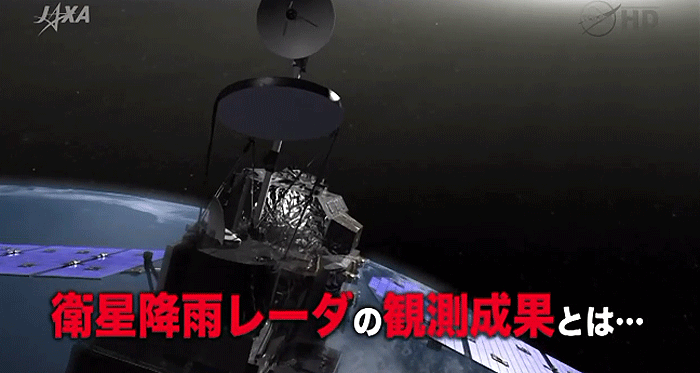TOBISHIMA, Aichi Prefecture--The Japan Aerospace Exploration Agency (JAXA) has developed its most cost-effective H-2A series rocket to date.
The H-2A Launch Vehicle No. 23, equipped with two auxiliary boosters, is 120 kilograms lighter than the previous model due to a new simplified engine design, making it cheaper to launch and manufacture.
The first stage of the rocket measures 37 meters in length and weighs 12 tons. The second stage measures 11 meters in length, with a weight of 2.6 tons.
The launch vehicle, 4 meters in diameter, was shown to reporters on Jan. 16 at Mitsubishi Heavy Industries Ltd.’s plant in Tobishima.
The H-2A is scheduled to carry the Global Precipitation Measurement (GPM) core observatory satellite into orbit on Feb. 28. The launch vehicle will take off from JAXA’s Tanegashima Space Center on Tanegashima island, located about 80 km south of Kyushu island.
The GPM satellite was jointly developed by JAXA and NASA to measure global precipitation.
Quelle: The Asahi Shimbun
.
Update: 21.01.2014
.
JAXA-NASA observatory to improve ability to analyze global precipitation
.
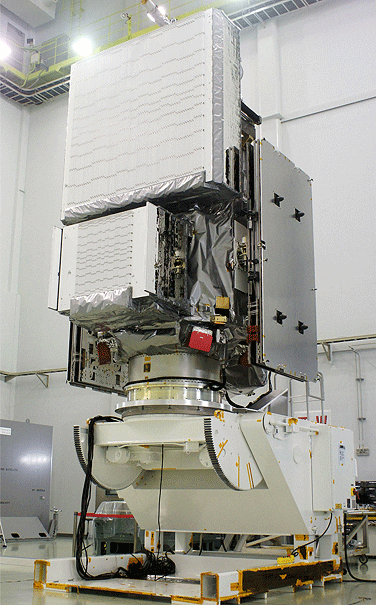
GPM JAXA NASA
.
KAGOSHIMA – The Japan Aerospace Exploration Agency (JAXA) on Friday revealed the details of a global precipitation observatory that will be put into orbit next month.
The Global Precipitation Measurement core observatory was jointly developed by JAXA and NASA. Unlike conventional satellites, the 4-ton, 6.5-meter-high facility has a cutting-edge dual-frequency precipitation radar that can observe any kind of rain, from very fine to extremely heavy, JAXA said.
“This could result in enhancing the accuracy of our projections of disasters caused by typhoons and heavy rain, while also contributing to studies of global warming and climate change,” said JAXA’s Masahiro Kojima, the 58-year-old project manager of the GPM project.
JAXA plans to put the GPM in orbit using an H-IIA F23 launch vehicle scheduled to blast off from Tanegashima Space Center in Kagoshima Prefecture on Feb. 28. The launch vehicle, made by Mitsubishi Heavy Industries Ltd., will also be carrying seven small satellites developed by Shinshu, Kagawa, Tsukuba and Kagoshima universities.
Quelle: The Japan Times
.
Update: 28.01.2014
.
NASA, JAXA Prepare Rain and Snow Satellite for Launch
The world enters a new era of global weather observing and climate science in February with the launch of the Global Precipitation Measurement (GPM) Core Observatory, a new international science satellite built by NASA.
GPM, a joint mission between NASA and the Japan Aerospace Exploration Agency (JAXA), is scheduled to launch Feb. 27 from Tanegashima Space Center in Japan. The observatory will link data from a constellation of current and planned satellites to produce next-generation global measurements of rainfall and snowfall from space.
The GPM mission is the first coordinated international satellite network to provide near real-time observations of rain and snow every three hours anywhere on the globe. The GPM Core Observatory anchors this network by providing observations on all types of precipitation. The observatory's data acts as the measuring stick by which partner observations can be combined into a unified data set. The data will be used by scientists to study climate change, freshwater resources, floods and droughts, and hurricane formation and tracking.
“The water-cycle, so familiar to all school-age young scientists, is one of the most interesting, dynamic, and important elements in our studies of the Earth’s weather and climate,” said John Grunsfeld, associate administrator for NASA's Science Mission Directorate in Washington. “GPM will provide scientists and forecasters critical information to help us understand and cope with future extreme weather events and fresh water resources."
The GPM Core Observatory will fly 253 miles (407 kilometers) above Earth in an orbit inclined 65-degrees to the equator. This orbit allows the Core Observatory to observe precipitation from the Arctic Circle to the Antarctic Circle at different times of day so it is able to observe changing storm and weather systems that behave differently during day and night. Normal operations will begin about 60 days after launch. Data will be downlinked through NASA's Tracking and Data Relay Satellite System to the agency's Goddard Space Flight Center's Precipitation Processing Center in Greenbelt, Md., where it will be processed and distributed over the Internet.
GPM's Core Observatory carries two instruments to measure rain and snowfall: the Dual-frequency Precipitation Radar (DPR), designed by JAXA and the National Institute of Information and Communications Technology in Japan, and built by NEC Toshiba Space Systems Ltd., Tokyo; and the GPM Microwave Imager (GMI), provided by NASA and built by Ball Aerospace & Technologies Corp. in Boulder, Colo. Together, these two instruments will collect improved observations that will allow scientists to better "see" inside clouds. In particular, they both provide new capabilities for observing smaller particles of rain, ice and snow.
"Knowledge of how water moves around the Earth system through precipitation is vital for monitoring freshwater resources," said Gail Skofronick-Jackson, GPM project scientist at Goddard. "The data from the GPM mission provides unprecedented measurements of global precipitation. The GPM Core Observatory will observe detailed characteristics of rain and snow systems that are also extremely important for improving weather and climate forecasts."
The DPR precipitation radar adds a new frequency with which to observe precipitation, allowing it to capture ice and light rain. It will return three-dimensional profiles and intensities of liquid and solid precipitation that will reveal the internal structure of storms within and below clouds.
The GMI is a microwave radiometer designed to sense the total precipitation within all cloud layers. In addition to collecting data on heavy to moderate rain, four new channels will be sensitive to light rain and snowfall, two types of precipitation that are especially prevalent in mountain regions and the higher latitudes over North America, Europe and Asia.
Together, DPR and GMI will provide observations on the size, intensity and distribution of raindrops and snowflakes. Scientists will be able to use this data to look at how precipitation behaves and influences weather and climate patterns. These patterns affect the distribution of fresh water around the world, impacting supplies for drinking water and agriculture.
The GPM Core Observatory, built by Goddard, will launch on an H-IIA rocket provided by JAXA. Mitsubishi Heavy Industries Ltd. is managing the launch.
GPM Core Observatory is the latest mission to support NASA's mission to monitor Earth's vital signs from land, air and space with a fleet of satellites and airborne and ground-based observation campaigns. NASA develops new ways to observe and study Earth's interconnected natural systems with long-term data records and computer analysis tools to better see how our planet is changing. The agency shares this unique knowledge with the global community and works with institutions in the United States and around the world that contribute to understanding and protecting our home planet.
Quelle: NASA
.
Update: 31.01.2014
.
GPM satellite to usher in a new era of weather observation
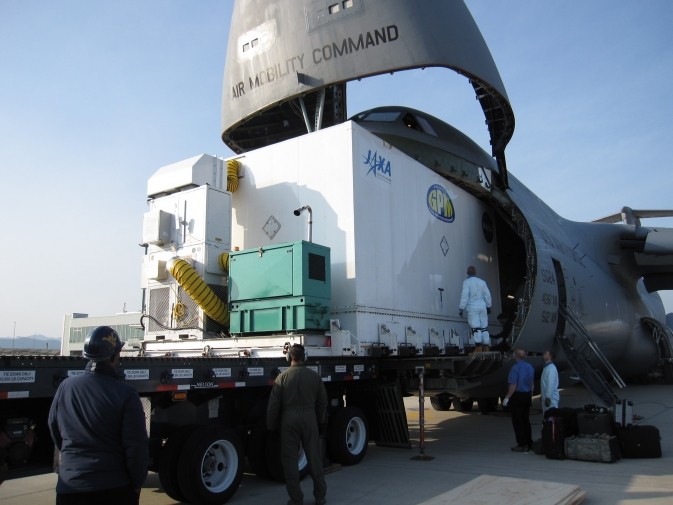
GPM's shipping container being unloaded from the U.S. Air Force C-5 cargo plane that carried it to Japan (Photo: NASA)
.
A new satellite designed to take detailed, near real-time measurements of rain and snowfall on a global scale whilst mapping the interior of storm systems is set to launch. The Global Precipitation Measurement (GPM) Core Observatory has been in development since 2005 and is a collaboration project between NASA and the Japanese Space Agency (JAXA). The satellite is due to be launched on the Japanese manufactured H-IIA delivery vehicle from the Tanegashima Space Centre, Tanegashima Island, Japan, on February 27.
Designed to work in conjunction with a network of existing and planned satellites, the GPM will fly 407 km (253 miles) above the Earth in an orbit inclined 65-degrees to the equator, giving it the ability to provide near real-time observations of rain and snow every three hours for anywhere on the planet. Its ability to survey a greater area than ground based devices will provide a more complete picture of global precipitation. It can also assess precipitation in areas which would be difficult to reach from the ground such as high altitudes or remote areas.
The GPM mission is the successor to the Tropical Rainfall Measuring Mission (TRMM), which launched in 1997, and was the first satellite to measure rainfall in the tropics during different points in the day. This system of observation proved itself to be a significant improvement over previous techniques when monitoring extreme weather events such as tropical storms which can pose a very real danger to human life.
The GPM satellite uses the same sampling method as its predecessor, building upon its technology. It is equipped with a microwave radiometer which is used to measure the quantity and intensity of rain and snowfall, and also carries a dual-frequency radar with the ability to peer within the particles of a cloud system and send back highly detailed data of each individual cloud layer.
Furthermore, for the first time, the state of the art sensor suite sported on the GPM core observatory satellite has the capability to detect falling snow and light rain. This is a significant step forward in the observation of precipitation, as the inability to detect certain forms of precipitation such as snow represented a significant blind spot in any previous efforts to create a truly global observation system, as it is these types of precipitation that are more likely to occur in higher latitudes.
The GPM mission has many real world applications regarding observing the impact of differing levels of precipitation on the environment. It should prove to be a great asset in assessing global water cycles, which in turn can have a pronounced effect on agricultural output. The system could also provide greater warning for extreme weather systems such as floods and hurricanes. This would grant those in the path of such a storm more time to evacuate and therefore minimize the loss of life.
The satellite core has recently undergone its final testing period, which involved switching on all of its systems for the first time since its journey to the launch site. The process was completed with no significant problems leaving the GPM on schedule for launch.
The satellite is due to commence normal operations about 60 days after launch, with the data it collects to be processed and distributed over the internet.
.
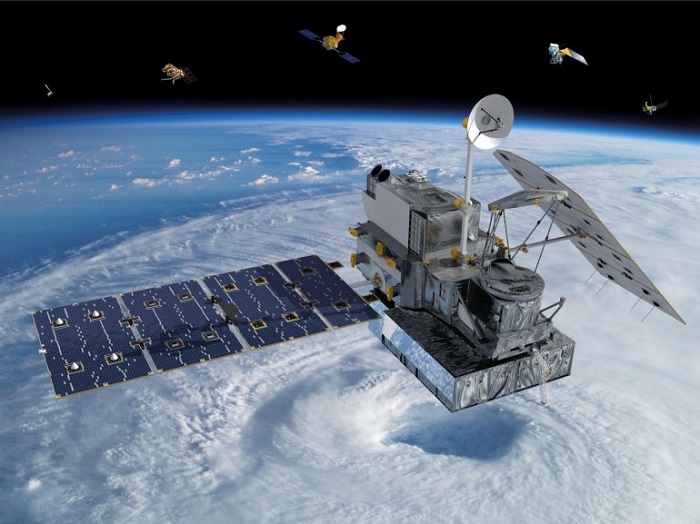
Quelle: gizmag
.
Update: 7.02.2014
.

H-IIA Launch Vehicle No.23, First stage VOS
GPM's launch vehicle, the H-IIA No.23, first stage VOS (Vehicle On Stand). Image Credit: Mitsubishi Heavy Industries
.
Attaching Solid Rocket Boosters to the HII-A Launch Vehicle
Attaching solid rocket boosters to GPM's launch vehicle, the HII-A No. 23. Image Credit: Mitsubishi Heavy Industries
.
GPM Status Update: Feb. 7, 2014
The Global Precipitation Measurement mission propulsion team completed fueling the Core Observatory spacecraft on Feb. 6 in the spacecraft and fairing assembly building at the Japan Aerospace Exploration Agency's Tanegashima Space Center, Japan. Afterward the propulsion team did leak checks.
GPM's fuel is hydrazine, which will power GPM's 12 thrusters that are used to maneuver the spacecraft so that it first enters then maintains its final orbit 253 miles (407 km) above Earth's surface. GPM will carry enough fuel for a minimum of five years of mission life.
.
Quelle: NASA
.
Update: 16.02.2014
.
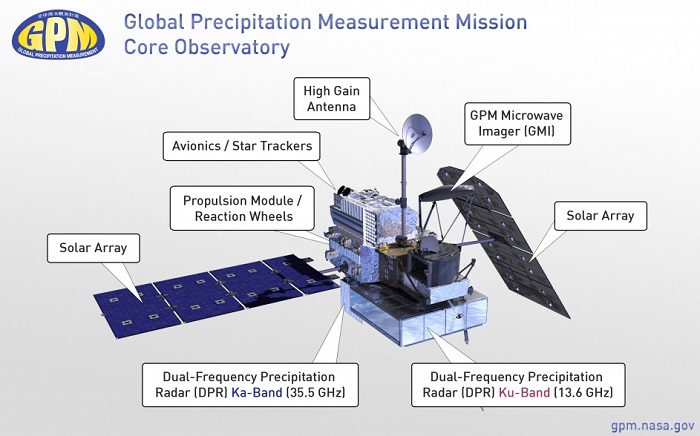
The foundation of the GPM mission is the Core Observatory satellite provided by NASA and JAXA. Data collected from the Core satellite serves as a reference standard that will unify precipitation measurements from research and operational satellites launched by a consortium of GPM partners in the United States, Japan, France, India, and Europe. The GPM constellation of satellites can observe precipitation over the entire globe every 2-3 hours. The Core satellite will measure rain and snow using two science instruments: the GPM Microwave Imager (GMI) and the Dual-frequency Precipitation Radar (DPR). The GMI captures precipitation intensities and horizontal patterns, while the DPR provides insights into the three dimensional structure of precipitating particles. Together these two instruments provide a database of measurements against which other partner satellites’ microwave observations can be meaningfully compared and combined to make a global precipitation dataset.
The Core Observatory satellite will fly at an altitude of 253 miles (407 kilometers) in a non-Sun-synchronous orbit that covers the Earth from 65°S to 65°N — from about the Antarctic Circle to the Arctic Circle. The GPM Core Observatory is being developed and tested at NASA Goddard Space Flight Center. Once complete, a Japanese H-IIA rocket will carry the GPM Core Observatory into orbit from Tanegashima Island, Japan in 2014.
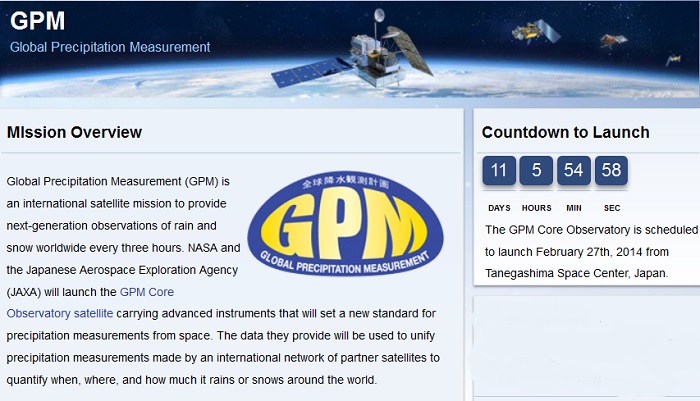
Quelle: NASA
.
Update: 22.02.2014
.
GPM Enclosed in Fairing
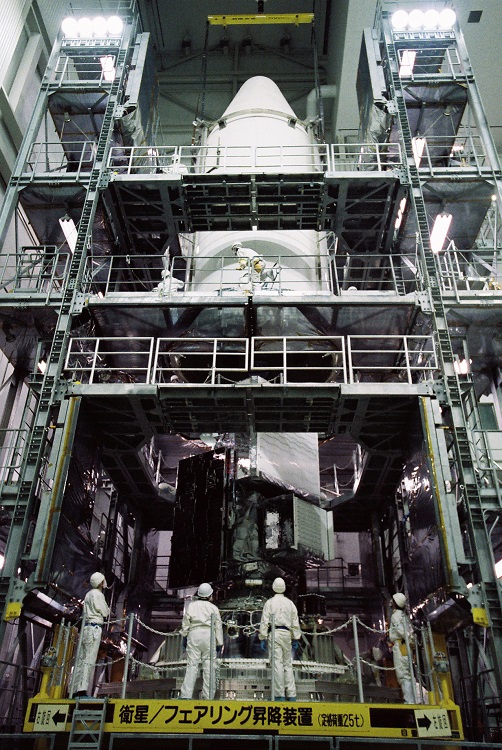
The fairing is lowered over the Global Precipitation Measurement mission's Core Observatory.
.
The Global Precipitation Measurement Core Observatory is scheduled to launch on Feb. 27 (EST) from Tanegashima Space Center, Japan. GPM is a joint mission between NASA and the Japan Aerospace Exploration Agency. The Core Observatory will link data from a constellation of current and planned satellites to produce next-generation global measurements of rainfall and snowfall from space.
On Feb. 11, the Core Observatory was moved into the spacecraft fairing assembly building and into the Encapsulation Hall. Final inspections and preparations were completed for the installation into the fairing, which began on Feb 13. The fairing is the part of the rocket that will contain the spacecraft at the top of the H-IIA rocket.
The encapsulation process for the H-IIA is very different than for most U.S. rockets. For U.S. rockets, the fairing is usually in two pieces that close around the payload like a clamshell. To install the GPM Core Observatory into the fairing of the H-IIA rocket, first the Core Observatory and the Payload Attach Fitting (PAF) are set up in scaffolding in the Encapsulation Hall. Then, the fairing is lifted above and lowered onto the fitting. When only a few feet remain above the final position, stanchions support the fairing while technicians go inside to complete the electrical connections. When this is completed, they remove the stanchions and lower the fairing to its final position, where it is bolted in place.
The GPM mission is the first coordinated international satellite network to provide near real-time observations of rain and snow every three hours anywhere on the globe. The GPM Core Observatory anchors this network by providing observations on all types of precipitation. The observatory's data acts as the measuring stick by which partner observations can be combined into a unified data set. The data will be used by scientists to study climate change, freshwater resources, floods and droughts, and hurricane formation and tracking.
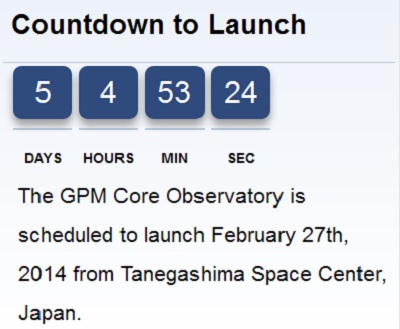
Quelle: NASA
.
Update: 24.02.2014
.

On the first floor of the Spacecraft Test and Assembly building at the Japan Aerospace Exploration Agency's Tanegashima Space Center, Japan, a skeleton crew of blue-shirted NASA engineers for the Global Precipitation Measurement (GPM) mission fill three rows of computer stations. Sitting with them, on top of one of the desktop computers, is a squat, roundish doll. About the size of a grapefruit, it’s bright red with a stylized, decorative face. Its most noticeable feature is that it only has one eye colored in.
"It's a Daruma doll," systems engineer Lisa Bartusek of NASA said during a lull in the launch dress rehearsal that took place Feb. 22 and 23, the weekend before the GPM launch. The doll is a symbol of good luck and in Japan is often given as a gift for encouragement to reach a goal. When you set a goal, you color one eye in, and when you reach your goal, you color in the other one, Bartusek said.
The goal for the GPM team in Japan? A good launch.
On Feb. 28 during a launch window that begins at 3:07 a.m. JST, the GPM Core Observatory is scheduled to blast into orbit aboard a Japanese H-IIA rocket. Due to the time difference with the United States, that's 1:07 p.m. EST on Feb. 27.
GPM is an international mission led by NASA and JAXA to measure rain and snowfall over most of the globe multiple times a day. To get that worldwide view of precipitation, multiple satellites will be contributing observations for a global data set, all unified by the advanced measurements of GPM's Core Observatory. Built at NASA's Goddard Space Flight Center in Greenbelt, Md., the Core Observatory is launching from JAXA's Tanegashima Space Center on Tanegashima Island.
Tanegashima is a small island off the southern coast of Kyushu, the southernmost of Japan's four big islands. It's about 35 miles long and 9 miles wide, similar in size to Guam, and covered in sugar cane and sweet potato farms as well as a dense subtropical forest. It's small town rural Japan, but as soon as you drive into the southernmost town of Minamitane rockets start appearing on every major signpost.
Minamitane is the closest town to Tanegashima Space Center. It has a few main streets, a mix of modern shops, '60s concrete facades, clapboard restaurants with brightly colored banners, and hotels studded with every JAXA and NASA mission sticker that's passed through the space center going back two decades.
Tanegashima Space Center is 20 minutes down a twisting highway east of town. As you enter the grounds, the road splits. Downhill goes to the Space Museum and Takesaki Observation stand, and the dense foliage gives way to a sloping beach and sandstone sea rocks off the coast. Visible to the north are the red and white towers of the two side-by-side launch pads of the Yoshinobu Launch Complex.
Construction of Tanegashima Space Center began in 1966, during the decade of the Space Race to the moon. At first, Tanegashima launched only small rockets for research and development. In 1994, they began launching the H-II rocket series capable of putting a two-ton satellite in geostationary orbit.
After two launch failures in the late 1990s, JAXA and their launch services provider Mitsubishi Heavy Industries (MHI) improved the H-II design and began launching the H-IIA series in 2001. This is the rocket that will take the GPM Core Observatory into orbit. Its launch record is 21 successful launches out of 22.
.

The launch pads at the Japan Aerospace Exploration Agency’s Tanegashima Space Center on Feb. 21, 2014, a week ahead of the planned launch of an H-IIA rocket carrying the Global Precipitation Measurement (GPM) Core Observatory.
Image Credit: NASA/Bill Ingalls
.
The road leading uphill winds along the hillside to the space center facilities. During the weekend of the dress rehearsal, three control rooms on site were up and running. At one of the first turns in the road is the Range Control Center, the main control room managed by JAXA which coordinates all launch activities and communications, including tracking the rocket after launch. Near the launch pad itself is an underground control room called the Yoshinobu Block House where the MHI team manages launch operations for the rocket.
Back at the Spacecraft Test and Assembly building, the first floor control room hosts the NASA GPM engineering team, each person seated at a console labeled with a different subsystem of the Core Observatory. Their job during launch is to keep the mission manager informed of what's going on with the satellite and to help resolve any issues that arise.
During the rehearsal "green cards," or anomalies, are thrown into the mix so that in the event that they happen on launch day, the team knows how to deal with them, said Glenn Bock, one of GPM's test conductors who coordinates activity in the control room and with the other control rooms, both here at Tanegashima and at Goddard, where the GPM Mission Operations Center is located.
They are online -- and on system engineer Tim Gruner's headset -- during this rehearsal. On launch day they'll be in the hot seat as soon as the spacecraft separates from the rocket. Their goal is after the GPM Core Observatory is flying free to get her pointed at the sun with solar arrays deployed and collecting power.
At Goddard, like in Tanegashima, the Mission Operations Center has a launch support room where rows of computers labeled by subsystem are staffed by the NASA GPM engineering team that built the Core Observatory.
"There's a Daruma doll in the launch support room at Goddard, too," Bartusek said. On both sides of the Pacific, both halves of the GPM team are waiting to color in that second eye.
.
Quelle: NASA
.
Update: 26.02.2014
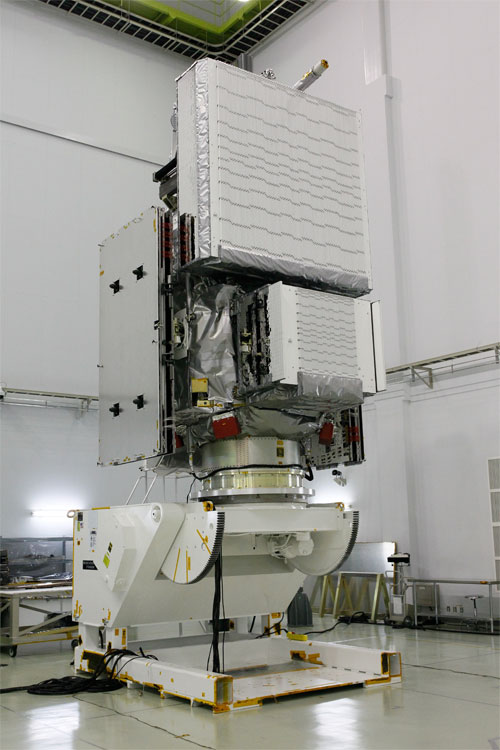
.
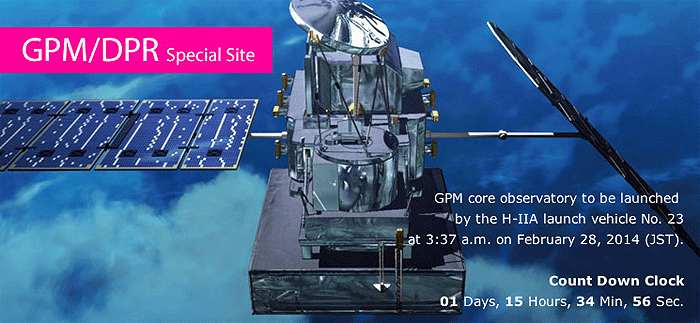
Quelle: JAXA
.
Update: 22.45 MEZ
.
Feb 26: GPM Go for Launch
The GPM Core Observatory has received a green light for launch!
On the morning of Feb. 26 (Japan time) at Tanegashima Space Center, chief officers from Mitsubishi Heavy Industries, Ltd., the Japan Aerospace Exploration Agency (JAXA) and NASA reviewed the readiness of the Global Precipitation Measurement (GPM) Core Observatory for launch on an H-IIA rocket on Feb. 28 (Japan time). All launch vehicle and launch facility actions relevant to the GPM launch were reported complete. The review panel gave the approval to proceed with launch.
The Launch Readiness Review confirmed a change to the launch time. Launch is now scheduled for a one-hour window that opens Feb. 27 at 1:37 p.m. EST (Feb 28 at 3:37 a.m. JST). The change was made after a collision avoidance analysis between the GPM spacecraft and the International Space Station.
If the launch is delayed by one day or into March, a new collision avoidance analysis will be conducted and a new launch window set within a two-hour window beginning 1:07 p.m. EST (3:07 a.m. JST).
The weather forecast is favorable for launch. Weather at T-0 is forecast to be some scattered clouds with light winds, neither of which are expected to affect launch. Winds at launch are forecast to be 13 mph (violation is 47 mph).
The H-IIA launch vehicle is scheduled to roll out of the Vehicle Assembly Building on Feb. 26 at 11 p.m. EST (Feb. 27 at 1 p.m. JST) and move to the launch pad. Weather is not expected to affect the rollout.
.
Countdown to Launch
20
HOURS44
MIN2
SEC
The GPM Core Observatory is scheduled to launch February 27th, 2014 from Tanegashima Space Center, Japan.
Quelle: NASA
.
Update: 27.02.2014 / 9.00 MEZ

...
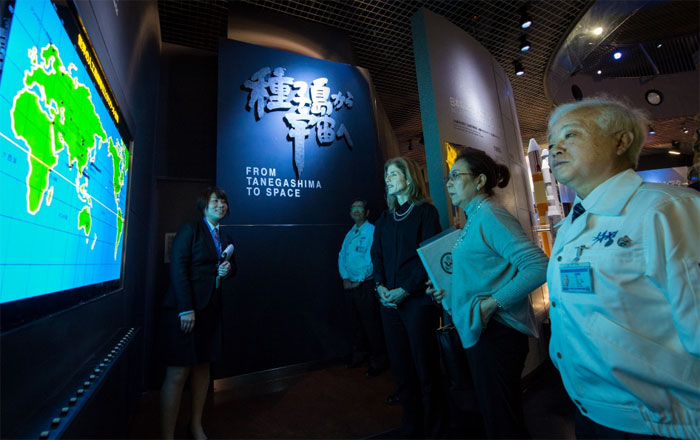
U.S. Ambassador to Japan Caroline Kennedy Tours Tanegashima Space Center
Caroline Kennedy, U.S. Ambassador Extraordinary and Plenipotentiary to Japan, center, tours the Tanegashima Space Center Visitors Center with Japan Aerospace Exploration Agency (JAXA) President, Naoki Okumura, right, on Thursday, Feb. 27, 2014, Tanegashima, Japan. The Ambassador is visiting the space center and hopes to witness the planned launch of a Japanese H-IIA rocket carrying the NASA-JAXA, Global Precipitation Measurement (GPM) Core Observatory. Once launched, the GPM spacecraft will collect information that unifies data from an international network of existing and future satellites to map global rainfall and snowfall every three hours.
.
...
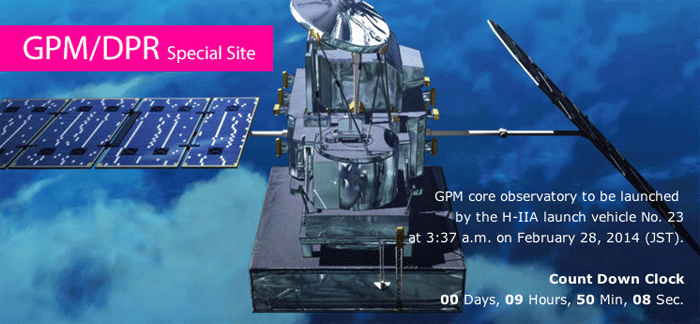
GPM/H-IIA F23 launch time decided! Live broadcast from 2:50 a.m. on Feb. 28 (Fri.) (JST)
The launch time of the H-IIA Launch Vehicle No. 23 with the core observatory for the Global Precipitation Measurement mission onboard was set for 3:37:00 on February 28 (Fri.), 2014 (Japan Standard Time).
JAXA will begin a live launch broadcast from the Tanegashima Space Center from 2:50 a.m. on the day.
.
.
.
.
.
.
Satellite carrying Ball Aerospace instrument lifts off in Japan
A NASA satellite carrying instrumentation built by Ball Aerospace & Technologies Corp. was successfully launched today on schedule from the Tanegashima Space Center in Japan.
The Ball Aerospace contribution to the mission, carried into space by a Mitsubishi Heavy Industries H-IIA launch vehicle, is called a Global Precipitation Measurement Microwave Imager, a multi-channel conical-scanning microwave radiometer.
The instrument will fly aboard the GPM Core Observatory satellite, along with the Japan Aerospace Exploration Agency's dual-frequency precipitation radar instrument. The Ball precipitation measurement instrument's task is to capture precipitation intensities and horizontal patterns, while the Japanese instrument provides insights into the three-dimensional structure of rain, snow and other precipitation particles.
The satellite will offer unprecedented three-dimensional views of hurricanes and snowstorms, and enhance the ability to monitor and forecast events including droughts, floods and landslides.
The satellite lifted off at 11:37 a.m. MDT.
Quelle: Boulder News
.
Landmark four-ton weather satellite blasts off from Japan
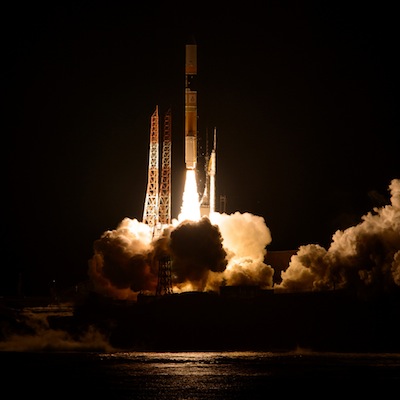
The GPM Core Observatory launched at 1837 GMT (1:37 p.m. EST) Thursday, or 3:37 a.m. local time at Tanegashima Space Center, Japan.
Japan launched a $1.2 billion joint satellite mission with NASA on Thursday to measure global rain and snowfall, filling coverage gaps and anchoring an international orbital network to supply scientists and forecasters a radar-like snapshot of global precipitation every three hours.
Data from the Global Precipitation Measurement satellite fleet will help predict a range of natural cataclysms, from floods and cyclones to drought and famine.
The 8,500-pound satellite launched from southern Japan on Thursday is the network's centerpiece, helping officials tie together disparate measurements into a single dataset, a one-stop shop for researchers interested in global precipitation patterns.
"Why are we flying GPM? Rain and snowfall affect our daily lives in many ways," said Steven Neeck, NASA's associate administrator for Earth science flight programs. "The distribution of precipitation in space directly affects the availability of fresh water for sustaining life. Extreme precipitation events like hurricanes, blizzards, floods, droughts and landslides have significant socio-economic impacts on our society."
The GPM Core Observatory lifted off atop a Japanese H-2A rocket Thursday at 1837 GMT (1:37 p.m. EST) from Tanegashima Space Center, an idyllic island launch base off the southern shore of Japan's main islands at the intersection of the Pacific Ocean and the East China Sea.
Coated in orange insulating foam to preserve reservoirs of super-cold liquid oxygen and liquid hydrogen propellants, the 174-foot-tall launcher lit its core main engine and two strap-on solid rocket boosters to race away from the Tanegashima spaceport, where it was 3:37 a.m. local time Friday.
Provided by the Japan Aerospace Exploration Agency and built by Mitsubishi Heavy Industries Ltd., the two-stage rocket accelerated through the speed of sound in less than a minute, dimming from a brilliant fireball to a star-like point of light in live video broadcast from the launch site.
The H-2A released its two solid rocket boosters about two minutes after liftoff, then jettisoned its first stage about six-and-a-half minutes into the flight.
The second stage engine ignited for an eight-minute burn, racing over the Pacific Ocean to a speed of more than 17,000 mph before turning off and deploying its Earth observation primary payload about 16 minutes after launch.
,
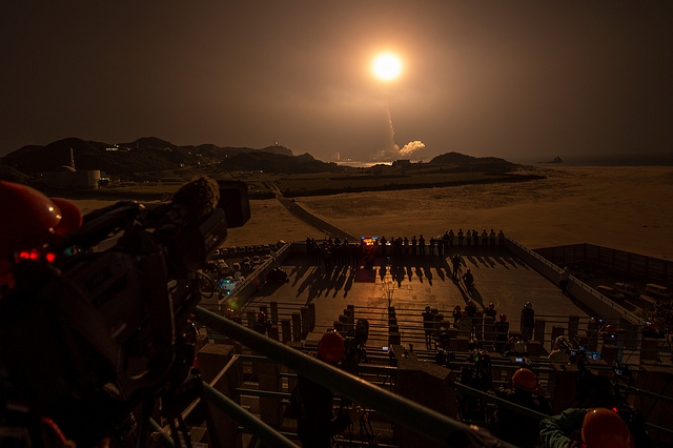
Liftoff of the H-2A rocket as seen from the press viewing site about 2.3 miles from the launch pad. Credit: NASA/Bill Ingalls
.
The rocket was programmed to later separate seven small secondary satellites for Japanese scientists and university students.
The GPM observatory unfurled two solar array wings to begin charging its electrical batteries, according to NASA engineers. The spacecraft was supposed to deploy a high-gain communications antenna a few hours after launch.
Art Azarbarzin, GPM's project manager for NASA, said the satellite's two instruments will be activated in the first week of the mission. Then officials plan two months of commissioning to verify the satellite and its research sensors are working as designed.
GPM will orbit at an altitude of 253 miles, or 407 kilometers, and fly between 65 degrees north and south latitude, peering into clouds, severe storms, cyclones and blizzards to gauge precipitation rates around the world.
The satellite will extend coverage of ground-based weather radars into undeveloped countries, the oceans and polar regions.
"The difference from ground radar is ground radar can measure a limited area, but spaceborne radar can measure the whole world," said Kinji Furukawa, JAXA's deputy GPM project manager.
It joins nearly a dozen other satellites already flying or in development in an international fleet to give scientists a worldwide view of precipitation every three hours.
Radar and microwave observations from GPM Core Observatory launched Thursday will serve as a reference for the other spacecraft, allowing researchers to create a uniform database updated eight times a day.
"We need to measure precipitation frequently both at the local and regional scales so that we can follow fresh water through the water cycle of the Earth," said Gail Skofronick-Jackson, NASA's deputy GPM project scientist. "We use the GPM Core Observatory as an anchor, an anchor to hold together all the rest of the constellation members."
The GPM constellation includes satellites from the United States, Japan, France, India and Eumetsat, the European weather satellite agency.
The GPM Core Observatory was built at NASA's Goddard Space Flight Center in Greenbelt, Md., and development of its microwave imager was led by Ball Aerospace and Technologies Corp. under contract to NASA.
Japan supplied the precipitation radar and H-2A launcher.
NASA's budget for the mission is $933 million, paying for the spacecraft, microwave instrument and ground systems. JAXA invested $226 million into the project to cover the radar and launch vehicle, putting the mission's total cost at nearly $1.2 billion.
GPM is the second collaborative precipitation measurement satellite developed by NASA and JAXA, following the successful Tropical Rainfall Measuring Mission launched in 1997. Now well beyond its design lifetime, TRMM is limited to detecting heavy rainfall in the tropics and subtropics.
"Thanks to TRMM, we have accumulated a lot of knowledge on tropical rain systems," said Riko Oki, the lead JAXA scientist for the GPM mission.
Engineers put GPM into a higher inclination orbit to cover the mid-latitudes up to the Arctic and Antarctic Circles.
Oki says GPM's radar has Ku-band and Ka-band functions. The new Ka-band radar frequency is sensitive to weaker rain storms and frozen precipitation.
The radar, manufactured by NEC Toshiba Space Systems, works like ground-based weather radars that supply imagery seen on news broadcasts and used to issue real-time severe storm warnings. The instrument sends out a radar wave and registers its reflection off water particles in the atmosphere.
The U.S.-built instrument on GPM will tally the sum of all precipitation contained within cloud layers. The 13-channel microwave imager will improve on the resolution of a similar sensor carried aboard the TRMM satellite.
The microwave radiometer has a 3.9-foot-diameter, or 1.2-meter, spinning antenna rotating at 32 rpm.
Skofronick-Jackson compares the mission to a health check-up for the planet.
With the dual-frequency radar, "we are able to have what we call a CT scan, it's a three-dimensional view of the precipitation and it's just like seeing three-dimensional within the cloud," Skofronick-Jackson says. "The GMI, on the other hand, I like to describe as an X-ray through the cloud. It's a projection of all the liquid and all the ice in the cloud.
"Just like a doctor uses CT scans and X-rays to diagnose what's happening in the human body, GPM Core Observatory is going to use the measurements of the radar and the radiometer to diagnose the precipitation strucutures within the cloud."
With its upgraded radar, GPM will see tiny raindrops and ice crystals suspended in clouds and falling to Earth, detecting rain and snowfall rates as little as 0.2 millimeters per hour. That's barely enough to wet a windshield.
"We are actually going [to see] from 0.2 millimeters per hour all the way up to 110 millimeters per hour, and we're able to detect snow," Skofronick-Jackson said. "There are some areas of the world that get all of their rain in very light rainfall events, other areas of the world may have these periodic monsoon seasons where they're getting very heavy rain, and there are other parts of the world that get a majority of their fresh water through frozen precipitation. We need to measure all those phases.
"On the other hand, for drought and for early famine warning when you think your crops are going to fail, we need to know how little it's going to rain, too. GPM is going to be able to tell us that as well."
Quelle: SN



